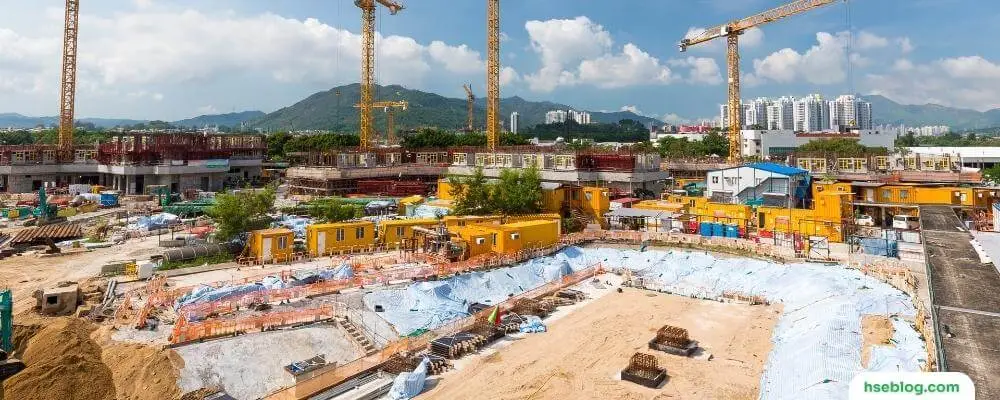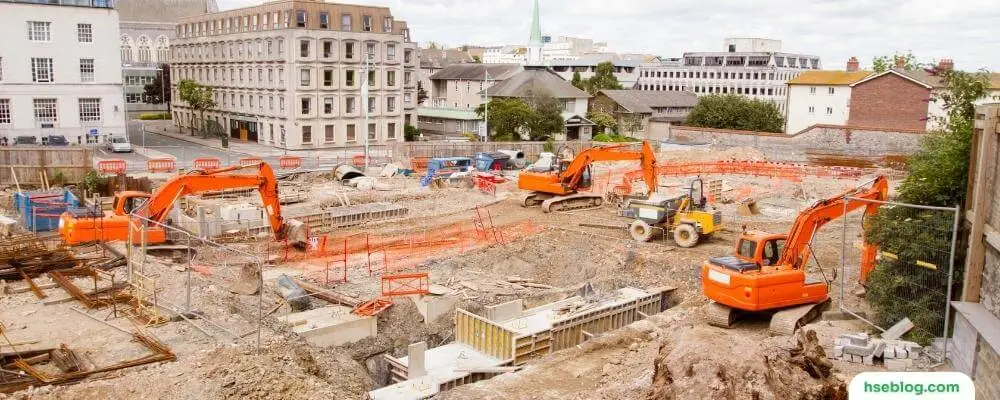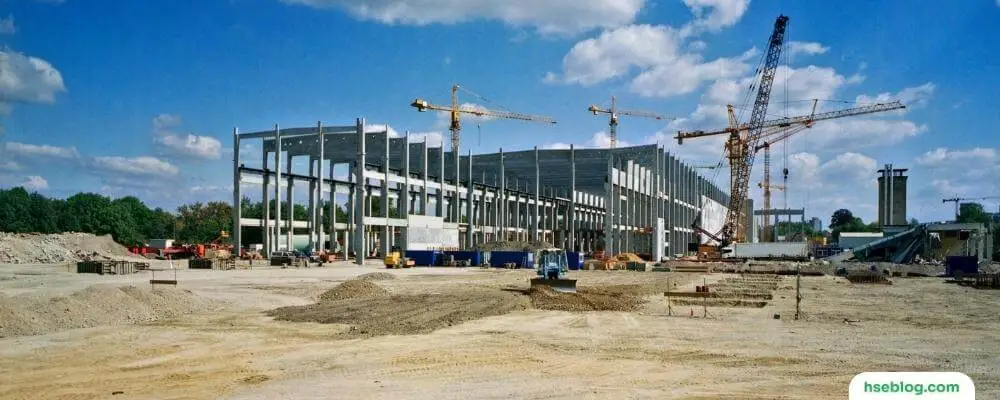Chemical hazards are present in many construction site environments. These hazards can come from various sources, including chemicals used in the construction process, chemicals stored on-site, and chemicals in the soil or water at the construction site.
Exposure to chemical hazards can cause various health effects, ranging from mild skin and eye irritation to more serious effects like cancer. Some chemical hazards can also be fatal. It is important for construction workers to be aware of the potential hazards they may face on the job and to take steps to protect themselves from exposure. This blog post will discuss some of the most common chemical hazards encountered on construction sites and how to protect yourself.
There are various ways to protect yourself from chemical hazards on a construction site. One of the most important things you can do is familiarize yourself with the Materials Safety Data Sheets (MSDS) for all the chemicals you may be exposed to on the job. MSDSs provide information on the hazards of a chemical, as well as safe handling and storage procedures.
Chemical Hazards On a Construction Site
Chemicals are found in many products used at construction sites. Workers may be exposed to dangerous chemicals during construction activities. These include asbestos, lead, silica, carbon monoxide, and spray paints. The chemicals can exist in several forms, including:
- Dust, fumes, and fibers (solids);
- Liquids and mists; and
- Gases and vapors.
These chemicals can enter the body in a variety of different ways. Let’s take a closer look.
- Inhalation (breathed in) – Inhalation is generally the most common way chemicals can enter the body in a work situation.
- Ingestion – accidental swallowing through eating, drinking, or smoking.
- Absorption – absorbed through contact with skin or eyes.
- Injection – a chemical enters the body when the skin is punctured.
Chemical hazards are prevalent on construction sites and can pose risks to the health and safety of workers. These hazards can arise from various sources, including the use of chemicals in construction processes, storage of hazardous substances, and environmental factors. It is important for construction workers to be aware of these chemical hazards and take appropriate measures to protect themselves.
Some common chemical hazards on construction sites include:

1. Health Effects from Chemical Exposure
There are two types of health effects of chemical exposure.
- Acute
- Chronic
Note: Some chemicals, such as carbon monoxide, have acute and chronic effects.
Acute Effects
These effects occur immediately or within a short time (minutes or hours) following exposure. Death is possible from some hazardous substances. Exposure to the chemical is typically sudden, short-term, and with a high concentration. For example, workers exposed to carbon monoxide may quickly experience a headache, collapse, or even death.
Chronic Effects
Chronic effects usually develop after continual or repeated exposure to a dangerous chemical. This long-term exposure can sometimes occur over several years. For example, a worker could develop lung cancer from long-term asbestos exposure.
2. Asbestos Exposure
Construction workers may be exposed to asbestos during the demolition or remodeling of older buildings built before 1980. Most of these buildings contain asbestos insulation or other asbestos-containing products. Asbestos is well-recognized as a health hazard and is highly regulated. Although asbestos is no longer an insulation material, workers may still be exposed to asbestos during demolition or remodeling jobs.
Asbestos may also still be found in taping compounds, asbestos cement, pipes, and floor tiles. Vinyl asbestos floor tiles may be as much as 15% to 20% asbestos, which is released when old flooring is removed. Asbestos removal can only be done by specially trained asbestos workers. Significant asbestos exposure can cause breathing problems, lung cancer, and lung lining cancer many years after exposure.
3. Welding Fumes
Welding fumes contain various chemicals depending on what is being welded, the chemical makeup of welding rods, fluxes, and shielding gases. Workers who experience the symptoms listed below should leave the area immediately, seek fresh air and obtain medical attention.
- Acute exposure to welding fumes and gases can result in eye, nose, and throat irritation, dizziness, and nausea.
- Prolonged exposure to welding fumes may cause long-term effects such as lung damage and various types of cancer, including lung, larynx, and urinary tract.
Health effects from certain fumes may include metal fume fever, stomach ulcers, kidney damage, and nervous system damage. Prolonged exposure to manganese fumes can cause Parkinson – like symptoms.
Gases such as helium, argon, and carbon dioxide displace oxygen in the air and can lead to suffocation, particularly when welding in confined or enclosed spaces. Carbon monoxide gas can form, posing a serious asphyxiation hazard.

4. Solvents
A variety of solvents with varying degrees of toxicity are used in construction. They are in paints, glues, epoxies, and other products. Health hazards associated with solvent exposure include:
- Toxicity to the nervous system,
- Reproductive damage,
- Liver and kidney damage,
- Respiratory impairment, cancer, and
- Dermatitis.
Generally, the possibility of exposure to excessive amounts of solvent vapors is greater when solvents are handled in enclosed or confined spaces.
Symptoms of overexposure to solvents include:
- Irritate your eyes, nose, or throat;
- Make you dizzy, sleepy, give you a headache or cause you to pass out;
- Affect your judgment or coordination;
- Cause internal damage to your body; and
- Dry out or irritate your skin.
5. Silica
About 2.3 million workers are exposed to respirable crystalline silica in their workplaces, including 2 million construction workers who drill, cut, crush, or grind silica-containing materials such as concrete and stone, and 300,000 workers in general industry operations such as brick manufacturing, foundries, and hydraulic fracturing, also known as fracking.
Quartz is the most common form of crystalline silica. In fact, it is the second most common surface material accounting for almost 12% of the volume of the earth’s crust. Quartz is present in many materials in the construction industry, such as brick and mortar, concrete, slate, dimensional stone (granite, sandstone), stone aggregate, tile, and sand used for blasting. Other construction materials that contain crystalline silica are asphalt filler, roofing granules, plastic composites, soils, and to a lesser extent, some wallboard joint compounds, paint, plaster, caulking, and putty.
Exposure to excessive silica dust causes lung scarring and disease over time. The size of the airborne silica particles determines the amount of risk. Smaller particles can be inhaled deep into the lungs where they can cause damage. Larger particles, such as beach sand, are not as great a concern because they are too large to inhale.
6. Lead
Lead is very toxic and can cause several long-term health problems. Construction workers can be exposed to lead on bridge repair work, paint removal on metal structures or buildings, demolition of old buildings with lead paint, or using lead solder. The frequency and severity of medical symptoms increase with a lead concentration in the blood. Common symptoms of acute lead poisoning are:
- Loss of appetite
- Nausea
- Vomiting
- Stomach cramps
- Constipation
- Difficulty sleeping
- Fatigue
- Moodiness
- Headache
- Joint or muscle aches
- Anemia
Acute health poisoning from uncontrolled occupational exposures has resulted in fatalities. Chronic overexposure to lead may result in severe damage to the central nervous and reproductive systems. It can also cause high blood pressure, anemia, kidney disease, and brain damage.

Control Measures Of Chemical Hazards On Construction Site
- The best way to protect workers from chemical hazards is to use engineering controls, which remove or isolate the hazard at the source. The next best measure is to use administrative controls, limiting worker exposure by changing work tasks. Personal protective equipment (PPE) should be used only as a last resort because it does not eliminate or reduce exposure and may create other hazards.
- There are four basic types of engineering controls: ventilation, substitution, process change, and enclosure/isolation.
- Ventilation is the most common form of engineering control used in construction. It involves using local or general exhaust ventilation to remove contaminants from the air before reaching the worker’s breathing zone.
- Substitution is the replacement of hazardous material with a less hazardous one. For example, using water-based paint instead of solvent-based paint or power tools with dust collection systems instead of hand tools.
- Process change is a modification to how a task is performed to reduce exposure. For example, using a power washer instead of a pressure washer to remove lead-containing paint from a surface.
- Enclosure and isolation are physical barriers that keep workers away from hazards. Enclosures can be as simple as plastic sheeting around an area where work is being performed or as complex as a negative air pressure containment booth. Isolation involves separating the hazard from the worker, such as using a remotely operated power tool to remove asbestos insulation.
- Administrative controls involve changing how work is scheduled or performed to reduce exposure. For example, restricting certain chemicals to specific tasks or areas, increasing ventilation in a work area, or providing workers with more frequent breaks.
- Personal protective equipment (PPE) includes clothing, gloves, eye and face protection, respiratory protection, and hearing protection. PPE is typically used as a last resort when engineering and administrative controls are not feasible or effective in reducing exposure to a hazard. It is important to remember that PPE does not eliminate or reduce exposure and may create other hazards. For example, if respirators are not fit-tested and worn properly, they can increase exposure by creating a seal around the face that prevents proper ventilation. Clear chemical hazard signs can also serve as an additional layer of protection by alerting workers to the presence of hazardous substances.
Conclusion
In conclusion, construction sites pose significant chemical hazards that can harm workers’ health and safety. Exposure to asbestos, lead, silica, welding fumes, and solvents can lead to acute or chronic health issues, ranging from immediate symptoms to long-term illnesses. It is essential for construction workers to be aware of these hazards and take proactive measures to protect themselves.
Implementing engineering controls, administrative controls, and proper personal protective equipment (PPE) is crucial to mitigate the risks associated with chemical hazards. Engineering controls, including ventilation systems and process modifications, should be prioritized to eliminate or minimize hazards at their source. Administrative controls, such as proper scheduling and work practice modifications, can also reduce exposure. PPE should be used as a last resort when other control measures are not feasible or effective.
Overall, a comprehensive approach that combines hazard awareness, effective control measures, and regular training is necessary to ensure the well-being of construction workers in the face of chemical hazards. By taking these steps, we can create a safer construction environment and protect the health of those working in the industry.

